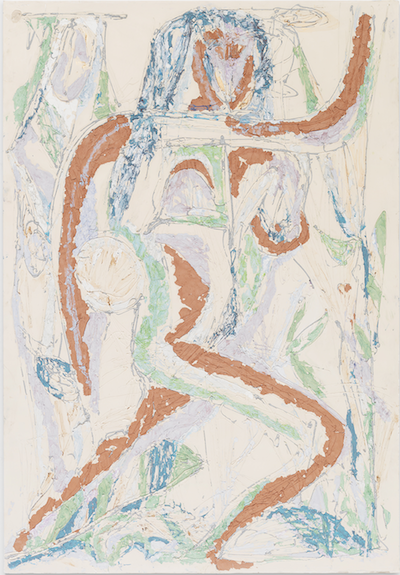Johannes VanDerBeek: Early Hand
Zach Feuer
548 West 22nd Street
New York, NY
Runs through October 04, 2014
What’s on view: Abstract paintings with roughly worked surfaces attached to metal fencing; flat sculptures; all seem to loosely relate to the human figure in a very Paul Klee/art brut fashion. Also, lots of white and pastels.
Corinna: “Following the birth of his daughter, VanDerBeek became fascinated with imagining how she was seeing the world without the pre-associations that language provides.” This is directly from the press release.
For an exhibition seeking to figure out how children see the world, the paintings and sculptures looked very much like what Modernists might have imagined early human cultures, or “primitives” made—“Running in the Grass,” for example. I’m not sure if I understand the impulse to make art that looks like former movements. It reminds me of that Classical Greek trend we saw in net art a few years back—on VVORK especially—that pops up again from time to time. In the worst case, it doesn’t seem like anything other than art historical mimicry.
I did see some childlike curiosity with the ultra-flat sculptures that look completely different from one side to another—children might see these as two different sculptures rather than two sides of the same coin. Or it’s a simple optical trick. Other than that, I didn’t find much else in terms of a childlike way of seeing; mostly I found an an interest in “Matissean” motion in VanDerBeek’s scratched into, built-up canvases. I appreciated the care VanDerbeek took to color the backs of his canvases, though.
Whitney: I didn’t think much of the childlike premise, since this is a highly sophisticated palette and process—the tastefully chromatic grey paintings look like poured paint and plaster that has been sliced professionally to create super-flat panels—and in a tactful showroom arrangement, the work just happen to dovetail perrrrfectly with the current Frieze fair trends. This is not to say it isn’t beautiful; I wanted to decorate my room with this. It’s just exactly the kind of work identified in Jerry Saltz’s June piece “Zombies on the Walls”:
This work is decorator-friendly, especially in a contemporary apartment or house. It feels “cerebral” and looks hip in ways that flatter collectors even as it offers no insight into anything at all. It’s all done in haggard shades of pale, deployed in uninventive arrangements that ape digital media, or something homespun or dilapidated. Replete with self-conscious comments on art, recycling, sustainability, appropriation, processes of abstraction, or nature, all this painting employs a similar vocabulary of smudges, stains, spray paint, flecks, spills, splotches, almost-monochromatic fields, silk-screening, or stenciling.
Whatever it’s about, the end result always seems to look like it’s commissioned by the same collector, and this definitely fits that bill. And I couldn’t agree more with Saltz’s conclusion:
Everyone will instantly stop making the sort of painting that was an answer to a question that no one remembers asking—and it will never be talked about again.
I know I’m just copy-pasting a review here, but how many times does this have to be said? The market is killing art, and critics have been saying it since at least the sixties. It’s reached such an extreme now, though, that there’s barely any point in going to Chelsea anymore.
Paddy: Unless you want to go shopping. But why bother if you can’t afford any of it and have seen every art making approach on view a hundred times over anyway?




{ 3 comments }
I think the desire to always be dazzled by something original is partly a function of being a critic. You could just as easily make the case that the expansion of criticism, via websites from AFC (which I like and read) to obscurantist journals (which I don’t), is ruining the art world by issuing an unfair demand for original, unsalable content all the time. And while new ideas are great and I love them, this hunger for them also panders to a romantic image of the tortured artist-as genius, which feels a bit stale and constricting with so many other models (curator, cook, crafter) kicking around now.
I guess I am just not sure why coming across art you would personally want on
your wall is a bad thing. That’s the art I like, and that’s the art I make.
Once you put down the yardstick of originality, you’re a lot freer to
create something you love.
I don’t think we’re looking for art that’s new—at least I’m not. And art that you want on your wall isn’t a bad thing. What I don’t want to do is show inert art on my walls; art that is somehow divorced from the creative energy of the studio and the community from which is born. Where that energy has gone is anybody’s guess, but it’s certainly not in this show.
Thanks for taking time to reply — appreciated. This is a subject I think about a lot, so it probably was wrong to respond pointedly to your post when this is an ongoing dialogue in my head always — but this issue also seems to be a real pressure point in art right now, so I welcome any and all conversation on the subject.
Comments on this entry are closed.